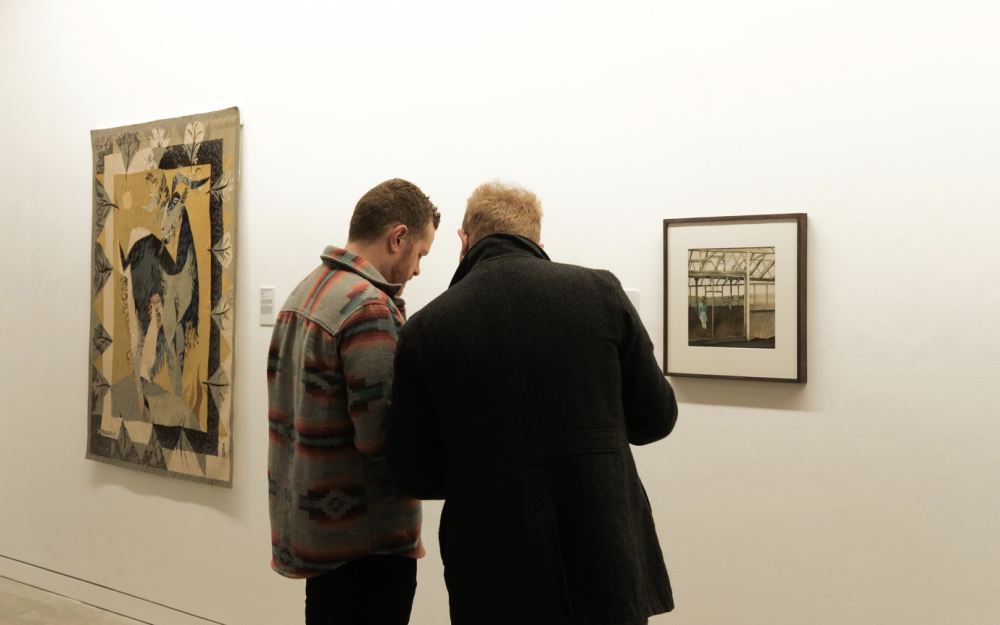Martin Gale’s work at RCC ‘Other Worlds’
Meditation as an event of the mind reflected and documented through the act of creating a painting is what I see in Martin Gale’s paintings each time I look there to see, to give it the existential attention his works deserve.
In the watercolour painting ‘The Appointment’ from 1983, one of Gale’s two works included in the ‘Other Worlds’ exhibition at the Regional Cultural Centre, I travel back to the point in time, a point in mind, with the painter to study a landscape lush with warm greens and intricate with the semi-derelict building structure at the forefront.
There is a most delicately painted young woman seen from behind, well dressed in the theatre that surrounds her. A painted world with a dramatically painted broken glass window, a transcendence that makes the viewer feel.
‘The Appointment’ reminds me of the painting ‘Hide and Seek’, done three years earlier and it looks like a series of sketches and paintings from the garden of the painter’s great aunt where he used to visit. The broken glasshouse also features in ‘Hide and Seek’, where the title suggests an unknown presence outside the painting. This suggestion is also present in ‘The Appointment’, with a strong connection or allusion to something which is outside or beyond the frame of the painting. Not knowing is a strong element in Gale’s paintings. We have no idea with who, where and when is the appointment, we only know this is a painting and it points out to a world imbued with a great portion of the unknown outside of it.

‘

Tournament’ from 2010 is an etching with aquatint likely done in the Graphic Studio in Dublin from the series of circus tents. There was a circus passing in the painter’s vicinity and he liked painting the tents and figures around them. The structures are humbled by the vast sky and landscape full of unknown possibilities.
Painting what is not there such as in Gale’s 2020 painting ‘Walking the Dog’, the absence of the person is seen in his footprints on the sand. In ‘The Appointment’, the absence of the other person is in the title and in the positioning of the young woman to one side of the composition inside the broken glasshouse. Something and someone is missing.
This way of arranging a figure or figures in a composition reminds me of the works of Edgar Degas where his dancers in many of his paintings occupy only a small portion of the canvas while the main part is a painterly elaboration of texture, mediums and paints describing interiors and walls. According to Gale in his interview on the ‘The Artists’ Well’ in 2021, his logic of arranging compositions was influenced by pop art after he finished NCAD in the seventies, though I can see a connection with many classical paintings, and this can be a subject for an interesting study.
A contemplation on nothingness or a lack is a metaphysical experience that alludes perhaps to our mortality, the innate vulnerability of being human, a child or an adult, we do not know where we come from, where we are heading to and what is the meaning of the road we are on. The paintings of Martin Gale are an expression of it and we participate in the mystery by standing in front of them, studying their details, and from there we move on with our inevitable reflections.
Away from painting, I like meeting Martin Gale in the occasions when we meet by chance. I like our short conversations, he speaks in a slow, thoughtful and a level headed kind of way and he generously explained precisely how he achieves the greenly tinged dark areas of the paintings in his last exhibition. He makes me feel good and happy as a person and his paintings make me feel that here is a hard working painter who takes care of the business of not knowing or nothingness in a serious and a most disciplined manner.
In the Anthropocene sadly our relationship with nature and land becomes remote. The exhibition ‘Other Worlds’ focuses the collection of works on such a connection which is apparent in the works of many of the artists, each one in his and her own way. This is a subject for another elaboration and I am only mentioning it here briefly to highlight the fact that this is the subject matter of the collection in which Gale’s work plays such a befitting role as do the works of Klute, Coyle, McCarthy, Haran, Cooke, Cross, Rolfe, Le Brocquy, Reilly and many others.

Daniel Lipstein is a painter and printmaker based in Donegal.
